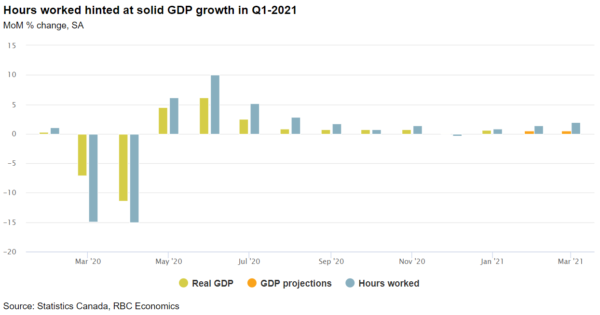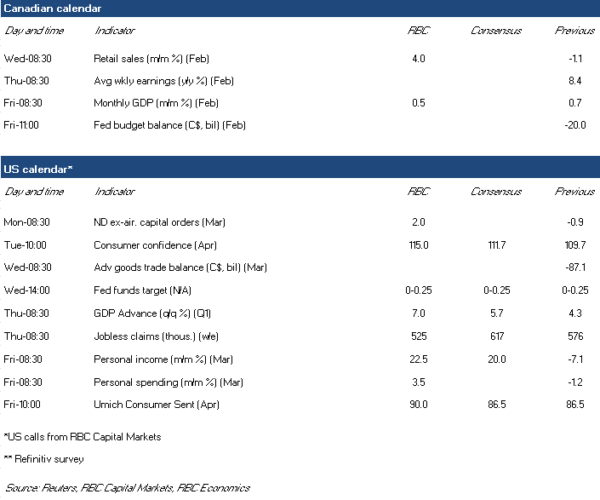Broader economic trends in Canada continued to improve in February and March, as containment measures eased (at least temporarily) following the winter wave of virus spread. Statistics Canada already reported a preliminary estimate that GDP rose 0.5% in February, and we look for a similar, if not larger gain in March. Retail sales rebounded in February after slowing in December and January. That combined with strength in construction and real-estate drove the increase in output. The gains were partially offset by weakness in manufacturing and wholesale trade amid a production slump in auto and parts (as a result of a global semi-conductor shortage), although early indicators from StatCan showed a rebound in both in March. Total hours worked jumped 1.4% in February and 2% in March resulting in an annualized 11% increase in Q1. That adds some upside risk to our forecast for a 6% GDP gain in the quarter.
Some of that recent strength, particularly in retail and hospitality, will likely be reversed in April with many containment measures re-imposed to tame the third wave of virus spread. RBC’s data showed spending on retail has eased again although, as in the second wave, the pullback was much smaller than in the spring of 2020. And sectors outside of those ‘high-contact’ service industries are expected to have held up reasonably well in April, as was the case over the winter. Substantial government policy supports are still in place – and are set to be extended through the summer – providing a floor for household incomes. And in the near-term, containment measures appear to be bearing fruit in some regions, with case counts trending lower (albeit still at very high levels) in BC and Quebec, and at least plateauing in Ontario over the last week. Widespread vaccination remains the path to a more open economy, and the rollout continues to pick up pace with about a third of the adult population now having received at least one dose – about double the share at the beginning of April.
Week ahead data watch:
- We expect the US Q1 advance GDP report to show a 7% quarter-over-quarter annualized gain, (a touch higher than consensus (+6.3%)) underpinned by a reopening of the economy as cases fell and vaccination progressed rapidly.
- Also in the US, both personal income and spending likely saw big increases in March, with households receiving the latest round of stimulus cheques as a part of President Biden’s $1.9 trillion COVID relief package.
- The improvement in economic conditions however are likely not enough to move the needle on monetary policy. Indeed, at next week’s FOMC meeting, we expect the Fed to reiterate their commitment in maintaining extraordinary support to the economy until inflation grows consistently around target and labour markets are fully recovered.














